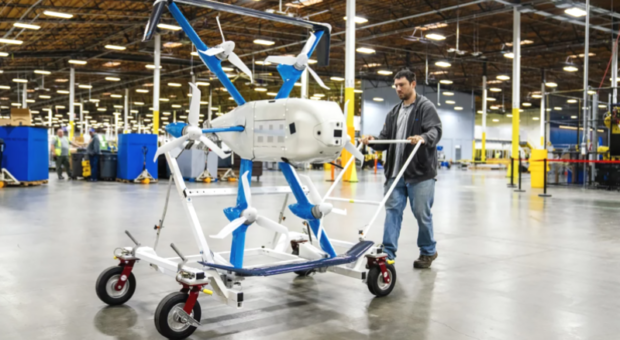Despite all of the excitement and all of the big investment in drone programs, we still don’t have drone delivery in most places. Food’s still being dropped off by gig drivers, and nobody’s getting a new iPhone 18XXL dropped onto their lawns. If anything, packages and deliveries happen slower than they did before.
There’s still demand for fast and cheap delivery with minimal environmental impact, but most of the big efforts have been closed down or left on the back burner. Why?
The video uses Phoenix, Arizona as a great example of a place that should be perfect for drones. The weather is usually good, the sprawl leaves a lot of room for deliveries, and the government in Arizona isn’t the kind to regulate drones to death the way a place like California or New York would.
But, there are some not-so-obvious problems.
First off, there’s the problem of airspace. Most of the city is in zones where drones can’t just be flown. Not only does Sky Harbor have restricted airspace, but there’s a bunch of small airports and an Air Force base. This leaves some big areas of the metro area where drones would really, really have to prove themselves before the FAA would even consider letting them fly without pilots in those areas. Permission is possible, but only on a flight-by-flight basis.
The other problem is the complex nature of the suburban environment. You’d think that big lawns and yards would leave a lot of room for drones to safely land and drop their cargo, but there are also trees, animals, people, and swimming pools that can challenge even the best autonomous drone software. As autonomous vehicles have shown us, even one accident can majorly hurt the industry, so this has to be perfect, despite perfection basically being impossible.
About the only safe way to do this at this point is to to keep the drones above the complexity and drop the packages into the landing zone with a parachute or a cable. But, even then, there still needs to be a pretty big space to do this safely. That’s not always available, even in single family housing.
This leaves only a very small percentage of homes serviceable by drones, even in Phoenix. Plus, Phoenix does occasionally have horrific winds, strong thunderstorms, and other weather that makes drones not work out. Outside of Phoenix, there are many places with harsh winters, rainy summers, constant wind, and other things that keep drones out of the air. So, once again, 30-minute delivery isn’t going to happen.
Then, add that range is limited, and you end up with some very small and isolate delivery zones, full of apartments, trees, and other places where drones can’t easily deliver. This leaves only small niches for drone delivery, and it doesn’t work at scale. The other thing is that people don’t want to pay for drone delivery. So, it’s only worth it in places where it could be done for the same price or cheaper than normal deliveries, which isn’t everywhere.
Given all of these limitations, there are other services that can do the job better. Not only are there gig workers who can move fast and not break things on bikes, scooters, and in cars, but autonomous vehicles that move along on the ground are another good alternative. Bad weather, FAA regulations, and other things can’t stop these things on the ground.
Autonomous vehicles have even evaded automobile regulations and the need for perfection by moving to the sidewalks. The little six-wheeled delivery robots have been able to do everything delivery drones can’t do without the cost of a poorly-paid gig worker. Most importantly, people don’t care how the package or food gets there as long as it does.
But, this doesn’t mean drone deliveries are worthless. There are some places where drones are still not only a good option, but the best option.
We’re really at the downhill side of the hype cycle. Initial expectations that drones would take over everything didn’t pan out, but this happens with new technologies all the time. But, when initial unreasonable expectations bust, we get to where we are right now, where it looks like the whole thing is a bust. But, over time, the industry self-corrects and the technology ends up being used for things that best fit it.
We’re starting to see that with drones. The niches where the technology best fits the needs are keeping drones, and companies aren’t trying to shove them into every task. Now, instead of crazy press releases, we’re seeing normal ones that don’t get a lot of attention. The small but actually workable stories don’t get the hype, but they get the job done.
In other words, we’re seeing real commercial implementations, like rural healthcare deliveries, where the technology can really do things we couldn’t do before.
What Ground EVs Can Learn From This
In some ways, this application of the hype cycle looks a lot like AVs. The initial hype was that autonomous vehicles would take over everything, and that maybe human driving would get banned. But, we’re seeing the hype bust now, and both sentiment and investment are going down. Operations are getting paused. Companies are going under or getting absorbed.
But, the technology, as seen in the video, is finding niche applications where it works well, like the little sidewalk rovers and as driver assist systems on highways. So, the hype cycle for that will probably work out in the end as something useful even if it doesn’t mean we get the whole utopian future that was initially promised.
Source: CleanTechnica

